Thought Leadership E-Articles |
Cost Segregation Studies: Opportunities for Contractors

Cost segregation studies, which identify certain building systems and components that qualify for accelerated depreciation, can offer important benefits to contractors who own their office, warehouse, or shop. But even contractors who do not own commercial property should understand what cost segregation studies do, the potential benefits they offer to building owners, and the role contractors can play in helping them realize those benefits.
How Cost Segregation Studies Work
Buildings, land improvements, and various types of personal property are depreciated on different schedules. Cost segregation studies identify construction-related costs that can be depreciated over these shorter time spans. This enables the building owner to accelerate tax deductions for depreciation.
For example, commercial property is typically depreciated over 39 years, and residential rental property—such as apartments, nursing homes, and multifamily housing projects—is generally depreciated over 27.5 years. But certain components and building systems—such as specialized electrical, plumbing, mechanical, and finish components—can qualify for shorter class lives, so they can be depreciated over five, seven, 10, or 15 years.
By enabling building owners to accelerate depreciation schedules, cost segregation studies can help reduce current tax obligations, increase cash flow, free up capital, and improve return on investment. This can make funding of a new construction project more feasible—a situation that benefits the building owner and contractor alike. In addition to improving cash flow on new construction, cost segregation studies can also provide tax and cash flow benefits for owners of existing structures.
For many commercial buildings, it is not unusual to find that 25 to 50 percent of the total costs are eligible for reclassification into shorter life asset classes. In other words, a cost segregation study for a $1 million property could generate more than $250,000 of accelerated depreciation.
It is never too late to perform a cost segregation study. If an owner did not take advantage of these benefits in the year a property was initially purchased or constructed, a look-back study could make it possible to claim all the prior years’ missed depreciation deductions in a single year.
How Tax Reform Has Increased the Benefits
Cost segregation studies became even more attractive when the Tax Cuts and Jobs Act (TCJA) of 2017 extended bonus depreciation, the 100 percent expensing of assets with a class life of 20 years or less. This means components such as equipment, furniture, landscaping, fencing, and parking lots do not have to be depreciated over five, seven, or 15 years, but instead can be written off 100 percent in the first year.
In addition, the TCJA expanded Section 179 to include certain improvements to nonresidential properties, such as new roofs, HVAC, fire protection, and security systems. Items qualifying for Section 179 can also be written off 100 percent in the year acquired.
More recently, the Coronavirus Aid, Relief, and Economic Security (CARES) Act included a long-expected technical correction to the TCJA, so that qualified improvements to nonresidential building interiors are also now eligible for bonus depreciation. A cost segregation study can identify all the building systems that qualify for immediate expensing under both the expanded bonus depreciation and Section 179 rules.
How Contractors Can Help—and Benefit
In its Cost Segregation Audit Techniques Guide, the IRS says, “Preparation of cost segregation studies requires knowledge of both the construction process and the tax law involving property classifications for depreciation purposes.” The guide adds that “unfortunately, there are no prescribed qualifications for cost segregation preparers,” but it strongly urges that studies be prepared by a qualified construction engineer. And although depreciation might seem straightforward, the details can get complicated, so a CPA’s guidance is also essential.
Many contractors have construction engineers and cost estimators on staff who can support the effort. But even if they don’t play a direct role, contractors can help streamline the process by coordinating with the study team from the beginning to be sure they capture the relevant information upfront, rather than having to go back and recreate it.
An astute contractor will want to understand and recognize the asset class life designations for various building systems and components to provide needed construction data in an organized way that helps the team complete the study quickly and accurately. By helping building owners achieve potential tax benefits and improve cash flow through cost segregation studies, contractors can deliver added value to their customers—and ultimately strengthen customer relationships.
The information reflected in this article was current at the time of publication. This article will not be modified or updated for any subsequent tax law changes, if any.
